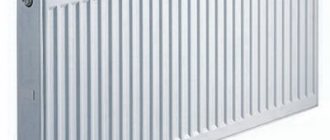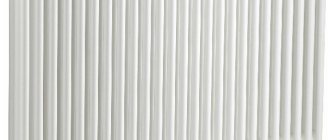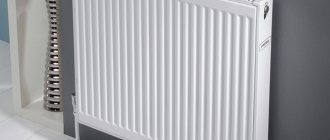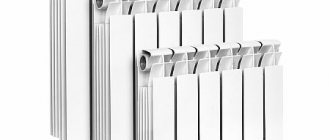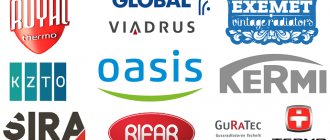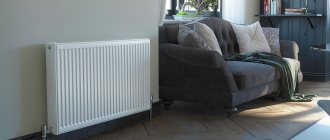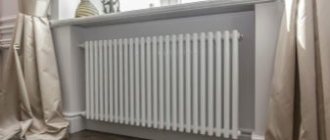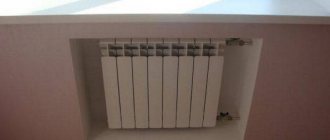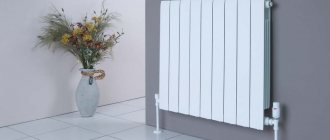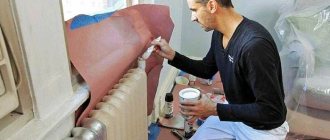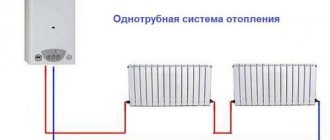Just a few decades ago, the only option for heating city apartments or office premises were heavy cast iron radiators. Today they have been almost completely replaced by functional steel products. We included the best models in the rating of steel radiators for 2022.
Expert's choice:
| Name | Price |
| 1. Axis Classic 22,500 | from 5600 rubles |
| 2. Kermi FKO 22 500 | from 5800 rubles |
| 3. Arbonia 2057 | from 22,000 rubles |
| 4. Zehnder Charleston 2180 | from 16,000 rubles |
| 5. Kermi FKO 11 500 | from 3500 rubles |
Mini rating
Steel radiator - general information
Steel radiator
Steel radiators are modern heating devices designed for heating rooms when operating in autonomous or centralized heating systems, including those with a low coolant temperature (+55...+70 degrees). The cost of this equipment is lower than aluminum or bimetallic analogues. Steel batteries heat up quickly, transfer heat to the room, but also cool down quickly.
The products are characterized by improved protection against physical and chemical factors and can withstand pressure drops in the network. Resistant to water hammer. Operate effectively at any coolant temperature. They have an attractive design that matches any decor. They can be horizontal or vertical. They differ in connection type and center distance.
What to look for when choosing a steel radiator
When purchasing batteries for an apartment or country house, you must take into account the technical parameters of these products.
Radiator type
By design, steel heating radiators are panel, sectional or tubular.
Panel
They look like two flat plates made of perforated steel, connected to each other by spot welding. This connection method ensures high quality seams and ensures a long service life of the products. Panel thickness – from 1.2 to 2 mm.
To improve heat transfer, panel models are equipped with U-shaped ribs made of thin sheet steel installed in the rear part. These structural elements perform the function of convectors that move heated air masses to the upper part of the room.
Please note: according to manufacturers, the average service life of such batteries can reach 25 years. But most often this period is shortened due to the poor quality of the coolant, which contains aggressive impurities that lead to corrosion of products.
Based on the number of convectors and panels, steel panel radiators are divided into several types, which have their own markings corresponding to the number of panels and “coil” convectors in the system. In everyday life, the most popular products are type 22, equipped with two panels, the same number of convectors and an upper bar. Or 33, with three panels, convector fins and a top grille.
Products with parameters 20 or 21 are not used for heating residential premises.
The main characteristics of these batteries include power and heat dissipation. The first indicator is determined taking into account the heat loss of the building in use, approved in the regulatory documentation. The material of the house, the type of its roof, the number of rooms and windows are also taken into account. Heat transfer is calculated based on the area of the heated surface and the number of heating sources.
Advantages and disadvantages
Improved heat transfer with compact dimensions due to the combination of the functions of a heater with a convector.
Resistance to mechanical damage and abrasive substances.
Variety of models in a wide size range.
Easy installation and maintenance.
Requires a small amount of coolant.
Weak resistance to water hammer;
Development of corrosion upon contact with impurities in the coolant.
Tubular
Steel tubular radiators in appearance resemble traditional cast iron models. They consist of vertical tubes connected to each other using an upper and lower manifold, ensuring efficient circulation of coolant in the device.
The level of heat transfer of this equipment is affected by the size, number of tubes located in one row, and their thickness. For Russian-made products it is 2 mm with a diameter of 25 mm. For Europeans it is 1.5 mm. Due to their greater thickness, Russian tubular batteries can withstand pressures of up to 22.5 atmospheres. European-made analogues can operate in a network with a pressure of up to 15 atmospheres. The number of tubes in a row for different models ranges from 1 to 6 units. Depth - up to 22.5 cm. Height of steel tubular radiators: from 30 to 300 cm.
Advantages and disadvantages
Resistant to pressure changes.
Antistatic properties (dust does not accumulate on them, falling down the smooth steel tubes).
Attractive appearance due to the smoothed internal and external surfaces (a model with certain parameters, shape, and dimensions can be made to order).
Easy to maintain due to the absence of ribs.
Tightness, high level of reliability.
Tendency to develop corrosion;
High price.
Products with laser welding are considered more durable in operation.
Connection type
Type of connection of devices
Devices are connected to the heating system in a side, bottom or diagonal way. The lower connection option is used when laying pipes under the floor or in walls, if it is not possible to lay them in grooved channels. The side type is more often used in apartments. In this case, the supply pipe is connected to the upper branch pipe of the battery, and the return pipe to the lower branch pipe. Both of these holes are on the same side of the radiator.
The diagonal method provides improved heat transfer. In this case, the pipe through which the coolant is supplied is connected to the upper branch pipe on one side, and the second, outlet pipe, to the lower branch pipe on the opposite side. When connecting in reverse, the supply pipe is located at the bottom and the outlet pipe is at the bottom.
It is advantageous to use a diagonal circuit for batteries with an increased number of sections (1 or more).
Heat dissipation
Power and heat transfer level are key indicators on which the operating efficiency of the radiator depends. If the battery is too hot, which means you have to ventilate the room all the time, this will create an unfavorable microclimate in the room and lead to excessive consumption of energy resources, that is, additional heating costs. If the heating is not enough, the room will not warm up as it should, which will also cause discomfort.
The heat transfer of a steel battery depends on the temperature of the carrier in the system, the size of the radiator and the thermal conductivity of the material from which it is made (steel). According to experts’ calculations, for normal heating of 1 m³ of room volume, 40 watts of thermal energy from the device is required. If there are windows, add 100 W to each of them. For each door - 150 W.
It is convenient to determine the required power of a steel radiator using the formula: Power = Room volume * 40 W + heat loss from windows + heat loss from doors. For different manufacturers, the power of these devices is 1200 - 1800 W.
Installation method
Methods for installing these heating devices depend on the type of connection, which can be:
- diagonal;
- bottom;
- lateral.
Important: When installing the battery, you must leave a gap of at least 25 mm between its back wall and the wall of the room. Otherwise, the heat transfer from the radiator will decrease. You should not use various decorative elements such as screens or curtains to disguise heating devices, since their presence will also reduce heat transfer and disrupt the operation of the temperature sensor.
The connection option is selected based on the type of battery, as well as the characteristics of the heating system. In apartments with centralized heating, it is better not to change the connection method, but to choose a suitable radiator model for it.
Pressure level
This indicator is influenced by the type of radiator battery. The standard pressure for operating plate models is considered to be 6–10 atmospheres, for tubular models – up to 15 atmospheres.
Minimum required thermal power
Typically, thermal calculations of houses are done infrequently, so calculations have to be done room by room. The power of all radiators should be 20% higher than the power of the boiler. For a house insulated according to GOST, heat loss is 10 kW per 100 sq. m. with a ceiling height of up to 2.7 m.
Determining the number of radiators in each room by area is not always reasonable. Heat loss depends on walls, windows, doors. You shouldn't hang too many batteries either. But there should be enough of them so that the system is not hot (>70°C).
Here is an example of power distribution:
- The inner room is heated by the neighboring ones and can be equipped with a minimum number of radiators.
- External wall and window – 1 kW per 10 m2.
- A long outer wall and two windows - multiply the previous figure by 1.2.
- Two external walls and a window - multiply by 1.3.
- Two external walls and two windows - we multiply the primary data by 1.4 or 1.5.
This definition of power is relative. Much depends on other characteristics of the house: layout, size of external walls and windows. But for more than 90% of standard Russian houses, such a simple calculation is quite enough.
Popular manufacturers of steel radiators
Zehnder (Germany)
Zehnder (
The largest manufacturer of tubular products, which is a constant leader in the European market. The brand’s radiators inside have a special protective coating that prevents the development of corrosion. Adapted for the Russian market.
Kermi (Germany)
Kermi
Batteries of the German brand operate with pressure up to 13 atmospheres at a maximum temperature of up to +110 degrees. Average heat output of brand devices: about 1158 W. Manufactured from reliable sheet steel 1 mm thick.
Purmo (Finland)
Purmo
The main advantage of the company's products is the increased level of heat transfer, which, depending on the model, is up to 3500 W. The brand's batteries are high-quality, durable, but expensive.
Kimry Thermal Equipment Plant (KZTO/KZTO) (Russia)
Kimry Heating Equipment Plant
The founder of the Russian heating equipment market. The company produces two series of tubular radiators: with a square (PC) or round manifold, as well as productive, powerful panel models with improved heat transfer and a modern, ergonomic design.
Elsen (Russia)
Elsen
The company specializes in the production of modern and functional panel heating radiators, whose technical parameters are not inferior to their European counterparts. For the production of equipment, high-quality cold-rolled low-carbon steel with a thickness of 1.25 mm is used. The panels are welded together using a continuous roller seam, ensuring their tightness and durability. Available in various sizes, with bottom or side connection.
Concern "Lidselmash" (Republic of Belarus)
Concern "Lidselmash"
Specializes in the production of flat steel heating radiators under the Lideya brand. For the manufacture of brand models, high-quality cold-rolled steel with a thickness of 1.2 mm is used. Lideya heating devices are designed for autonomous heating systems of residential or industrial buildings. Available in various lengths and heights.
Reviews of low heating devices: advantages and disadvantages
| Advantages | Flaws |
| Small dimensions allowing installation of devices under any windows, as well as in rooms with insufficient free space | Greater cost compared to standard products. For one narrow battery you have to pay 2-3 times more |
| More comfortable heating, the lower and longer the heating device, the more even the room temperature and the better the entire volume of air is heated | Less efficient, since with the same width they have a smaller heat exchange area, and it is not always possible to install extremely wide radiators |
| Models with a height of 200 mm have a wide selection (any material, almost any manufacturer, various colors) | More demanding on the quality of the coolant. According to owner reviews, some models with complex designs clog quickly. This leads to air pockets |
| Stylish and modern appearance, most models do not need to be hidden from view | Shorter service life |
| The small volume of coolant (with the exception of tubular steel) makes the system more inert and functional | Slightly more complex installation |
Which radiators are best to buy for a private house and for an apartment?
Which radiators are best to buy for a private home
? For an apartment with a centralized heating system, it is better to choose sectional models. When purchasing, it is advisable to know the operating pressure in the system and the approximate composition of the coolant, since these are the factors that usually damage practical and functional steel models. If possible, it is better to purchase bimetallic heating equipment for a city apartment with a ribbed body made of lightweight, durable aluminum and an interior made of copper or hardened steel. Or made of reliable cast iron.
Both panel and tubular models of steel radiators are suitable for a private house with an autonomous heating system.
Please note: if you are looking for inexpensive batteries with a high level of heat transfer, you can choose products with a panel design.
Tubular radiators differ little in characteristics from panel radiators. Their main advantages: attractive design and hygiene. If you wish, you can order a model for your home based on your own individual sketch. The disadvantage of such products: high price.
Prices: summary table
| Model | Height, mm | Working pressure, atm. | price, rub. |
| Buderus Logatrend K-Profil 11 300 2000 | 300 | 10 | 6 930 |
| Kermi FKO 22 200 2000 | 200 | 10 | 8 599 |
| Purmo Ventil Compact 200 2000 | 200 | 10 | 11 400 |
| Radena CS 150 16 sections | 150 | 25 | 10 100 |
| Loten Gray Z 750 180 mm | 180 | 16 | 9 189 |
| Rettig Column H-2×200×700 | 200 | 10 | 7 800 |
Which steel radiator is best to buy?
When buying steel radiators for a house or apartment, you first need to decide on the type of equipment. Panel models are simple and compact in design. The heat from them is transferred to the room using the conventional method. Tubular batteries are aesthetically pleasing, have an original design, but are more expensive than panel ones. The heat in them circulates between the steel tubes included in their design, quickly warming up the space.
Another important parameter: height. The universal height of the batteries is 500 mm, suitable for any type of window sill. Also on sale you can find products with a height of 30, 40, 45, 50, 60 or 90 cm.
Convector size . We are talking about a curved serpentine plate that gives off heat. With a radiator height of 50 cm, the size of the convector should be 40 cm, with 5 cm gaps in the upper and lower parts.
Pressure level . This indicator, which can be found in the technical documentation for the device, must correspond to the network parameters. Otherwise the battery will simply burst.
Weight . For a standard model measuring 500 by 1000 mm, it should be at least 24 kilograms. If this parameter is less, this indicates insufficient thickness of the steel sheet, which can negatively affect the thermal parameters of the model. The thickness of the steel of the device must be at least 1.15 mm. This indicator is especially important for systems prone to water hammer.
Areas and features of application, effectiveness
Model SOLIRA 2020/4 No. 12 with a height of 200 mm and a depth of 70 mm.
Narrow batteries have become an alternative to conventional batteries in the face of changing building standards. They are ideal for panoramic and stained glass windows. In addition, large radiators do not always fit into bathrooms, toilet rooms, and balconies. With their miniature size, low batteries are practically not inferior to standard analogues in terms of efficiency, if the installation is carried out without violating technology.
Low horizontal structures are used in narrow rooms where there are low walls, partitions or panoramic windows. They are also indispensable for small loggias and balconies, as they do not take up much space. Narrow horizontal radiators are also installed in long rooms and corridors.
The main feature of such radiators is not even the size and dimensions, but the specificity of heating the room: the lower and longer the heating device, the more even the temperature of the room and the better the entire volume of air is heated.
Operating requirements
Thin steel heating radiator type 11 in the interior of the house.
Steel appliances should be used in enclosed areas where there is no harmful corrosive effect and moisture will not form on their surface. For example, you should not install steel equipment in bathrooms, laundries, baths, halls, swimming pools, car washes, and refrigerators. For the same reason, they cannot be installed in houses in the first year after completion of construction or during modernization, if the premises will not be heated.
Flat radiators can be used in both single-pipe and two-pipe heating systems, using pipes made of various materials: steel, copper or plastic, in which water or a special glycol mixture can be used as a coolant. Polypropylene pipes must be reinforced with a solid layer of aluminum to avoid oxygen diffusion (the penetration of air into the heating system from the outside, which can cause corrosion processes), and metal fittings and fittings must be used with them.
Flat radiators can be installed for systems with membrane expansion tanks. Here it is necessary to use tanks whose membrane is made of “Butyl” material, which protects the heating system from air penetration.
Also, the assembly of thin radiators is permitted in small open systems with forced circulation with limited thermal output, but provided that approved corrosion inhibitors are used. Please note that flat heaters are not used in systems with natural circulation of coolant, because it is impossible to ensure their sufficient heat transfer.
It is prohibited to install radiators in systems where the maximum operating pressure may exceed 9-10 bar and the operating temperature above 110-120°C. When checking the tightness of the system, the pressure should not exceed 12-13 bar. These values are typical for devices from the most famous manufacturers; More detailed information can be found in the equipment documentation.
Installations with steel radiators must be filled and topped up with water of the appropriate quality. Requirements for water characteristics vary from manufacturer to manufacturer, but the averages are as follows:
- the total content of chloride ions and sulfate ions is not higher than 150 mg/l (for copper pipes - not higher than 50 mg/l),
- oxygen content not higher than 0.1 mg/l,
- Water pH within 7.0 ÷ 10.0,
- water hardness is not higher than 4.0.
It is unacceptable to empty the heating system of water, except during failures. If an emergency arises, for example, during repairs, water should be removed only from the part where the work will be carried out. Once completed, the system must be immediately filled with water.
Annual water losses in the heating system should not exceed 5% for a closed system and 10% for an open one.
Flat-plate radiators should be cared for using cleaning agents that do not contain solvents, acids or other substances that cause damage to the paintwork and, as a result, corrosion.
Types of Flat Panels
The thinnest radiators on the market are represented by two types of panels: type 10 and type 11. At its core, a type is a numerical abbreviation in which the design of the device is encoded. The first digit of the type indicates the number of radiator panels, and the second digit indicates the absence (if “0” is used) or the presence of convection fins and the number of their rows.
Type 10: one of the thinnest single-panel radiators without convection.
Type 11: single panel flat radiator with 1 row of convection sheets.
A comparison of the features of thin heating radiators of types 10 and 11 is presented in the table.
| Device type | Photo | Peculiarities | Width, mm |
| Type 10 | Flat single-panel radiators without convection do not raise dust and are easy to maintain, therefore they are most often used in rooms with increased sanitary and hygienic requirements: in medical institutions, preschool and educational institutions, food and pharmaceutical manufacturing enterprises. | 46-50 | |
| Type 11 | Flat single-panel radiators with one convection row, due to which the heaters have a heat output 5-10% higher than their single-panel counterpart without convection. The presence of convection leads to the movement of air and, accordingly, dust, so this type of device requires more frequent and thorough surface care, otherwise their advantage over type 10 heaters will be lost. | 61-64 |
Some bimetallic models can also be classified as thin, for example, Oasis BM 500/80 with a thickness of 80 mm. Bimetallic heating devices are a more expensive alternative, but have greater heat transfer and a higher permissible operating pressure limit. They can be used if, according to preliminary calculations of heat transfer, even the widest steel radiators are simply not enough to heat the room.
Heat transfer from heating radiators Comparison of indicators and calculation methods
Calculation of the number of sections
It is not necessary to look for the most expensive heating devices to make the room comfortable. The main thing is to correctly calculate the number of sections. If the rooms are standard, then this greatly simplifies the calculations.
Often they resort to calculations based on the volume of space because they are simple, but at the same time give fairly accurate results.
- 1 m³ requires 41 W of power. If good double-glazed windows are installed and heat loss is minimal, then the indicator drops to 34 W.
- Room volume (m³) = area (m²) × height (m).
- Required heating power for the entire room (W) = room volume (m³) × 41 W (or 34 W).
- In the technical data sheets of devices, manufacturers indicate the heat transfer of one section.
- The total power (the value calculated in point 3) must be divided by the heat transfer of one section. The resulting number is the number of sections.
For example, the required thermal power is 2890 W, and the heat output of one section is 170 W. Then for this room you need to purchase 17 sections.
In a non-standard room, calculations are made using a more complex formula Source rmnt.mirtesen.ru
If the room is non-standard, the calculations become more complicated. To calculate the total power, the features of double-glazed windows (double or triple), thermal insulation parameters of the walls, the ratio of the sizes of windows and floors, ceiling heights and other parameters are taken into account. Designers calculate all this using specialized software.
